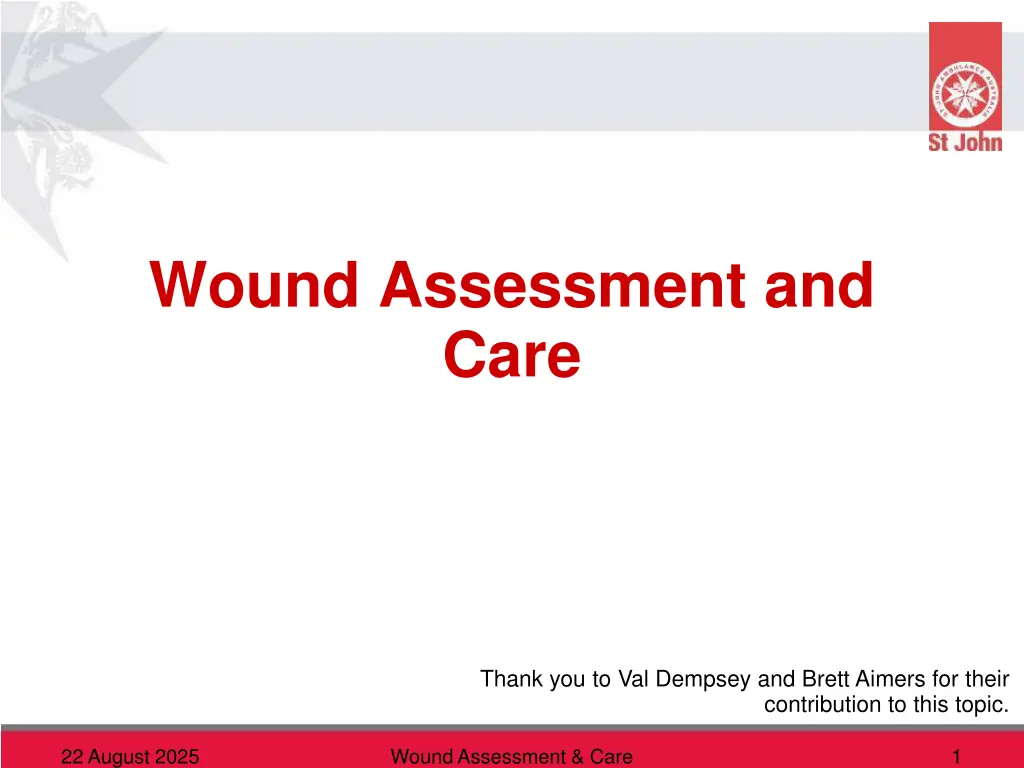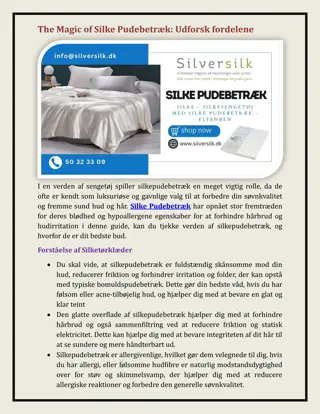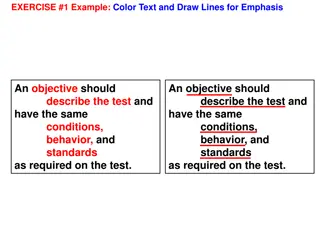
Understanding Wound Assessment and Care
Explore the fundamentals of wound assessment and care, including identifying different types of wounds, understanding factors affecting wound healing, and the variety of dressing products available. Delve into the physiology of the skin, normal wound healing phases, and the importance of maintaining a clean and moist wound environment for optimal recovery.
Download Presentation

Please find below an Image/Link to download the presentation.
The content on the website is provided AS IS for your information and personal use only. It may not be sold, licensed, or shared on other websites without obtaining consent from the author. If you encounter any issues during the download, it is possible that the publisher has removed the file from their server.
You are allowed to download the files provided on this website for personal or commercial use, subject to the condition that they are used lawfully. All files are the property of their respective owners.
The content on the website is provided AS IS for your information and personal use only. It may not be sold, licensed, or shared on other websites without obtaining consent from the author.
E N D
Presentation Transcript
Wound Assessment and Care Thank you to Val Dempsey and Brett Aimers for their contribution to this topic. 22 August 2025 Wound Assessment & Care 1
Learning outcomes At the end of this session, participants will be able to: Identify and care for different types of wounds Understand the factors that affect wound healing Understand the variety of dressing products available 22 August 2025 Wounds and Bleeding 2
What is a Wound? A wound is a break in the integrity of the skin Types of wounds include Grazes and abrasions Lacerations Incisions Puncture Avulsions and skin tears Blisters Mixed 22 August 2025 Wounds and Bleeding 3
Physiology of Skin Largest organ of the body Helps protect against infection Acts as a shield against injury When intact, protects internal organs Is waterproof Aids in the regulation of body temperature 22 August 2025 Wounds and Bleeding 4
Anatomy 22 August 2025 Wounds and Bleeding 5
Normal Wound Healing Tissue healing occurs in 3 phases 1. Reaction Phase Begins immediately after injury This is the inflammatory phase where: o Blood vessels contract and clotting occurs o Tissues swell o Cells migrate (including white cells) creating a local inflammatory process o Can last for 48 hours o Important to keep the wound clean and moist 22 August 2025 Wounds and Bleeding 6
Normal Wound Healing 2. Regrowth Phase New cells commence growing Collagen and extracellular fibres are laid down that will give strength to the scar New blood vessels grow Together the newly formed vessels and cells are known as granulation tissue Wounds that are kept moist during this phase heal more quickly Wounds with edges that approximate (come together) heal faster than wounds where the skin has to grow across the wound 22 August 2025 Wounds and Bleeding 7
Normal Wound Healing 3. Remodelling Phase Final Phase Scar tissue contracts Swelling disappears Wound continues to strengthen Continues for 6-12 months 22 August 2025 Wounds and Bleeding 8
Factors Affecting Healing Age (the elderly and young) Complex medical history o Diabetes o Vascular Disease o Immuno-compromised Nutrition Anti-platelet drugs (e.g. Warfarin, Aspirin) Infection Dressing selection o The right dressing promotes healing 22 August 2025 Wounds and Bleeding 9
Types of Wounds Grazes and abrasions Lacerations Incisions Puncture Avulsions and skin tears Blisters Mixed 22 August 2025 Wounds and Bleeding 10
Incision Description A straight cut with edges that oppose (come together neatly) Caused by A sharp object (e.g. knife or glass) Damage to the tissues Causes skin, soft tissue or muscles to be severed 22 August 2025 Wounds and Bleeding 11
Graze or Abrasion Description Scrapped off skin which can be superficial, deep or mixed May contain foreign objects or dirt Caused by Scraping across a hard surface Damage to the tissues Causes outer layer of skin and tiny underlying blood vessels to be exposed 22 August 2025 Wounds and Bleeding 12
Laceration Description A ragged edged wound, may have been torn, some tissue may be missing, edges may not oppose Caused by Sharp and or jagged objects (e.g. barbed wire, teeth or claws) Damage to the tissues Injury causes damage to skin and underlying tissues 22 August 2025 Wounds and Bleeding 13
Puncture Description A penetrating wound Appearing small on the surface May include an exit wound Caused by Sharp, penetrating or high velocity object Damage to the tissues Underlying tissues, muscles and organs High risk of infection 22 August 2025 Wounds and Bleeding 14
Avulsions or Skin Tear Description A ragged edged wound with underlying tissues exposed. May have a skin flap attached (skin tear) Caused by Caused by severe force or friction across surface of skin Damage to the tissues Damaged to skin and underlying tissue High risk of infection 22 August 2025 Wounds and Bleeding 15
Blisters Description Fluid filled sac involving layers of skin Caused by Heat or friction Damage to the tissues Mostly superficial, damaged area of skin may lead to infection 22 August 2025 Wounds and Bleeding 16
Dressing Selection The correct dressing will: Remove excessive ooze to prevent maceration of the surrounding tissue Allow gaseous exchange that supports new cell growth Be easy to apply, comfortable, adaptable Provide thermal insulation Act as a barrier to infection Not cause allergies or sensitivities Allow non-traumatic removal 22 August 2025 Wounds and Bleeding 17
Dressing Selection Dry dressings are used to Control bleeding Keep wounds clean, protected and covered Dry dressings are most suitable on Punctures Lacerations/ Cuts Blisters (closed or without skin loss) 22 August 2025 Wounds and Bleeding 18
Dressing Selection Dry dressings options include: Non- Adhesive Dressings Island Dressings Gauze Crepe bandage Combine Dressing Strips/ Adhesive Strips 22 August 2025 Wounds and Bleeding 19
Dressing Selection Moist dressings are used to: Retain moisture and trap nutrients in a wound Prevent dressing adhesion to wounds Promote faster wound healing Reduce scaring Keep wounds clean Moist wound dressings can be changed daily or left intact for several days 22 August 2025 Wounds and Bleeding 20
Selecting Wound Dressings Moist dressings are most suitable on: Grazes Abrasions Open blisters with tissue loss Skin tears/ Avulsions 22 August 2025 Wounds and Bleeding 21
Dressing Selection Moist dressings options include Occlusive film dressings Hydrocolloids Foams 22 August 2025 Wounds and Bleeding 22
Managing Wounds The management of a wound requires 6 steps 1. Identify wound type 2. Cleaning a wound 3. Inspecting wound 4. Selecting a dressing 5. Discharge summary/ documentation 6. Referral and discharge advice 22 August 2025 Wounds and Bleeding 23
Preparation Obtain consent Use PPE, wear goggles if necessary Control any bleeding Ensure comfort and privacy Check patient details, allergies, medications and history that may affect wound healing. If able, clean the surrounding skin 22 August 2025 Wounds and Bleeding 24
Infection Prevention Although the risk is low there are simple steps to protect both yourself and the patient Follow standard infection prevention procedures while providing wound care o Gloves (changes as often as required) o Goggles (as necessary) o Apron (if required) o Appropriate waste disposal 22 August 2025 Wounds and Bleeding 25
Identify Wound Type Abrasions Grazes Open blisters (with skin loss) Evulsions and Skin tears Punctures Lacerations/ Cuts Closed blisters Mixed 22 August 2025 Wounds and Bleeding 26
Identify Wound Type Uncontrolled Bleeding: Uncontrolled bleeding must be controlled as a first priority If uncontrollable, request immediate help Deep Wounds For deep wounds do not irrigate or clean, cover with a dressing and request help 22 August 2025 Wounds and Bleeding 27
Cleaning a Wound Refer to Operations Branch First Aid Procedures Dressing Pack o Open disposable dressing pack (check expiry date) o Pour ampoule of normal saline into container o Using sterile forceps to pick up saline soaked gauze No dressing Pack o Pour ampoule of normal saline into packet of sterile gauze squares, or flush wound with ampoule of normal saline 22 August 2025 Wounds and Bleeding 28
Cleaning a Wound 1. Gently irrigate wound with an ampoule of normal saline, do not scrub a wound as this may cause tissue damage 2. Swab from the centre to the outside (to avoid dirt being re-introduced into wound) 3. Use a new swab after each swipe, then discard. 4. Continue swabbing until wound it is as clean as possible 5. Dispose of gauze into normal waste 6. Chlorhexidine may be used in the cleaning of contaminated wounds or skin 7. Chlorhexidine must not be used on clean wounds 22 August 2025 Wounds and Bleeding 29
Inspecting a wound Inspect for the presence of foreign bodies o Is it free of foreign bodies after cleaning? Review the depth: o Does the wound need sutures? If foreign bodies cannot be removed with gentle irrigation, or cleaning with gauze, cover and refer to a health professional 22 August 2025 Wounds and Bleeding 30
Apply Dressing 1. Allow area around wound to dry 2. Apply a dry or moist dressing 3. Secure with tape or a crepe bandage as necessary 4. Check circulation if using a bandage to secure dressing 22 August 2025 Wounds and Bleeding 31
Documentation Complete documentation on an OB12 (Patient Record) o List the agent used to clean the wound o List the type of dressing selected o Record discharge advice and referral 22 August 2025 Wounds and Bleeding 32
Discharge Advice Ongoing dressing management Keep dressing dry for the first 24 hours (cover when in the shower) Change daily or as recommended by the dressing manufacturer or wound type If the old dressing sticks to the wound, wet or soak it to assist in removal All wounds initially dressed by a doctor or nurse should be re-dressed by a doctor or nurse This advice also applies to clinical members attending multi-day events 22 August 2025 Wounds and Bleeding 33
Discharge Advice Educate patients on identifying signs of infection and when to seek medical care: o Increased heat, swelling, redness o The wound develops an odour or pus-like discharge o If fever and/ or vomiting occurs o If the wound is not healing o If you have any other concerns 22 August 2025 Wounds and Bleeding 34
When to Refer? Refer patients to a health professional immediately if There is uncontrolled bleeding Deep wounds that require advanced care (e.g. suturing, steri-strips, gluing) Foreign matter cannot be cleaned from the wound It is an injury to the face, elbows, knees or genitalia The patient is experiencing severe pain The wound was caused by a human or animal bite There is numbness or loss of movement The wound is a skin tear on an elderly casualty, particularly if located below the knee 22 August 2025 Wounds and Bleeding 35
Immunisation If your patient has presented with a dirty and/or infected wound, the need for a Tetanus booster should be considered Has the patient had a recent Tetanus booster (in the last 5 years)? 22 August 2025 Wounds and Bleeding 36
Patient Scenario 1 A 76 year old lady presents after a fall with a wound to her forearm. She has a history of lower leg ulcers and takes Aspirin once daily. What is the wound type? How will you treat it? What discharge advice or referral would you give? 22 August 2025 Wounds and Bleeding 37
Patient Scenario 2 A 26 year old male presents to your first aid post 20 minutes after falling off his bike. He presents with multiple wounds that are bleeding minimally. He has no allergies. What is the wound type? How will you treat it? What discharge advice or referral would you give? 22 August 2025 Wounds and Bleeding 38
Patient Scenario 3 A 32 year old male presents after tripping over with a freely bleeding wound to his knee. The wound appears clean. He has a history of hypertension. What is the wound type? How will you treat it? What discharge advice or referral would you give? 22 August 2025 Wounds and Bleeding 39






















